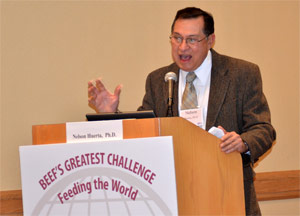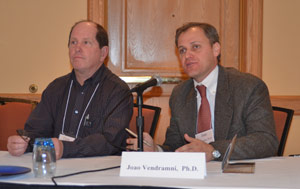ILC–USA 2012:
Latin America's Role
in Global Beef Production
by Kasey Miller for Angus Productions Inc.

Nelson Huerta photos by Kasey Miller
DENVER, Colo. (Jan. 10, 2012) — Latin America consists of 20 countries, 590 million people, a 2011 economic growth rate of 4%, and 400 million cattle. That means there are almost as many cattle on the continent as people, pointed out Nelson Huerta, U.S. Meat Export Federation (USMEF)-Mexico director of technical services, at the 2012 International Livestock Congress–USA (ILC–USA 2012) in Denver, Colo.
ILC–USA attendees heard from Huerta, the moderator of the session, and panelists Clint Peck, director of Montana Beef Quality Assurance (BQA), Bozeman, Mont., and Joao “Joe” Vendramini, assistant professor at the University of Florida's Range Cattle Research and Education Center, originally from Brazil.

Clint Peck and Joao “Joe” Vendramini photos by Kasey Miller
Brazil leads beef production in Latin America, being the third-ranked global exporter of beef behind the United States and Australia. In Latin American beef production, Argentina, Mexico, Colombia and Uruguay follow Brazil as top beef producers, Huerta said.
Peck illustrated some global trade priorities, including:
• phytosanitary and sanitary rules based on sound science,
• macro-economic growth to spur demand for beef,
• consumer-driven dynamics based on price and safety, and
• recognizing the law of comparative advantage.
To exemplify the law of comparative advantage, he mentioned that Latin American beef is defined by grass, as U.S. beef is defined by grain.
Foot-and-mouth disease (FMD), or “Aftosa,” is a big problem, but the continent is working through that. Uruguay, he said, has been free of the disease since 1995. He noted that Argentina also had problems with governemtal policy and regulations that caused a drop in beef production in 2009. Paraguay, though landlocked and often in the shadow of its neighbors, has good profitability opportunities, as quality and sanitary status are improving and there is little government interference.
Vendramini highlighted characteristics of the Brazilian beef industry:
• Extensive production systems with predominant use of Bos indicus breeds.
• The majority of cattle are on private land.
• About 90% slaughtered are finished on pasture, so it takes, on average, three years to finish calves.
• Production is not segmented, they have all aspects of the production cycle in each state, so carcasses travel, not the cattle.
• Animals are sold by liveweight or carcass weight; there are no quality grades.
• There are distinct prices for steers, bulls, heifers and cows.
• In general, the minimum slaught weight for males is about 1,000 pounds (lb.) and for females is 660 lb.
He also discussed some of the major challenges and future trends for the Brazilian beef industry, several of which are similar to those in the United States. He said that environmental regulations limit expansion of beef production to new native areas. Sugarcane and row crops are replacing areas formerly allocated to cattle, much like corn production here. Packing plants are being consolidated into a few larger plants, which leaves fewer options to market cattle.
There is a decreasing number of beef cattle producers with small operations, and there is a focus on cow-calf operations. Vendramini also mentioned that feedlots are getting larger, more commerical and owned primarily by packing plants.
There is a favorable Brazilian economic situation, there is an increase in beef consumption and, subsequently, beef cattle prices have increased, too. Additionally, the Brazilian beef cattle herd will likely continue growing due to increased productivity.
For additional coverage of ILC–2012, return to the ILC index page.
Editor’s Note: The above article was written under contract or by staff of Angus Productions Inc. (API). It may not be reprinted without express permission of API. To request reprint permision, contact the editor at 816-383-5200.
This section of the API Virtual Library contains event coverage provided by the editorial team at Angus Productions Inc. (API), publisher of the Angus Journal, the Angus Beef Bulletin, the Angus Beef Bulletin EXTRA and the Angus e-List. For questions about this site, to submit an article for our consideration, or to report a broken link, contact the editor at 816-383-5200; 3201 Frederick Ave., Saint Joseph, MO 64506.
API claims copyright to this website as presented. We welcome educational venues and cattlemen to link to this site as a service to their audience.






